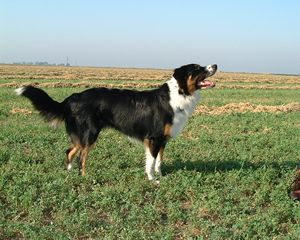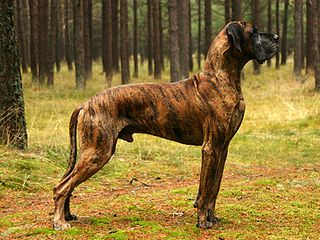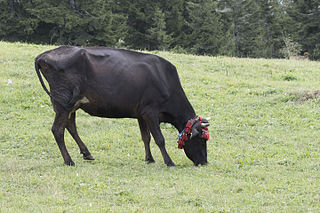
Dhanni is a cattle breed originating in the Punjab region of Pakistan and India, being mainly found in Attock, Chakwal, Fatehjang and tehsil Kot Fateh Khan, though it is used in other parts of the Indian subcontinent. [1]

Dhanni is a cattle breed originating in the Punjab region of Pakistan and India, being mainly found in Attock, Chakwal, Fatehjang and tehsil Kot Fateh Khan, though it is used in other parts of the Indian subcontinent. [1]
Dhanni is a medium size light draught breed of cattle. It is characterized with a straight back bearing a big hump, a small face, and short-alerted ears. It is found in different color ranges with different spots that can be either black, brown, or red. It has a long tail ending with white switch. Bulls of this breed are known to be having great agility. A male weighs around 400 kg while a female weighs 300 kg. It is mainly a draught breed and frequently seen racing in locally popular bull cart races. A racing bull becomes very precious and sometimes may be sold at five times the price of a regular bull.
The milk yield of females is around 1,000–1,200 litres. [2]
Dhanni bull have different names according to it color patterns:

The Highland is a Scottish breed of rustic beef cattle. It originated in the Scottish Highlands and the Western Islands of Scotland and has long horns and a long shaggy coat. It is a hardy breed, able to withstand the intemperate conditions in the region. The first herd-book dates from 1885; two types – a smaller island type, usually black, and a larger mainland type, usually dun – were registered as a single breed. It is reared primarily for beef, and has been exported to several other countries.

The English Shepherd is a breed of herding dog from the United States.

The Holstein Friesian is an international breed or group of breeds of dairy cattle. It originated in the Dutch provinces of North Holland and Friesland and in Schleswig-Holstein in northern Germany. It is the dominant breed in industrial dairy farming worldwide, and is found in more than 160 countries. It is known by many names, among them Holstein, Friesian and Black and White.

The Galloway is a Scottish breed of beef cattle, named after the Galloway region of Scotland, where it originated during the seventeenth century.

Brindle is a coat coloring pattern in animals, particularly dogs, cattle, guinea pigs, cats, and, rarely, horses. It is sometimes described as "tiger-striped", although the brindle pattern is more subtle than that of a tiger's coat.

The Braunvieh or Swiss Brown is a breed or group of breeds of domestic cattle originating in Switzerland and distributed throughout the Alpine region. It falls within the "Brown Mountain" group of cattle breeds. The Swiss Braunvieh was originally a triple-purpose animal, used for milk production, for meat and for draught work; the modern Braunvieh is predominantly a dairy breed.

The Herens is a breed of cattle named after the Val d'Hérens region of Switzerland. These small, horned alpine cattle are coloured black, brown or dark red, often with a lighter stripe along the spine. The cows are used in organised cow fights.

Kerry cattle are a rare breed of dairy cattle, native to Ireland. They are believed to be one of the oldest breeds in Europe, probably derived from small black cattle brought to Ireland by Neolithic man. They were probably also the first cattle bred mainly for milk production, with other breeds being developed mainly for draught and meat. The climate of southwestern Ireland was suitable for milk production year-round, and the Celts also stored milk in the form of cheese and butter.

The Sussex is a British breed of red beef cattle from the Weald of Sussex, Surrey and Kent, in south-eastern England. Its traditional use as a draught ox on the Weald continued into the twentieth century. From the late nineteenth century it began to be selectively bred for beef production. It has been exported to many countries of the world; the largest population is in South Africa, where there may be half a million head.

The Anatolian Black, also known as Native Black Cattle, is a breed of cattle that originated in Anatolia, in what is now Turkey. They are used in dairy production, meat production, and as draught animals on small farms. They are primarily raised in central Turkey.

The Danish Jersey is a modern Danish breed of dairy cattle. It derives from approximately 5200 head of Jersey cattle imported to Denmark from the island of Jersey between about 1896 and 1909. It is the most numerous population of Jersey cattle in Europe and constitutes approximately 13% of the Danish dairy herd.

The Ferrandaise is an endangered French breed of domestic cattle from the département of Puy-de-Dôme, in the Massif Central mountains of Auvergne, in central France. It is named for the city and commune of Clermont-Ferrand, the capital of Puy-de-Dôme.

Philippine cattle are the indigenous cattle breed found throughout the Philippines. It is a small breed with mature bulls weighing about 400 kg and mature cows weighing about 300 kg. The color ranges from grey to brown to fawn, with white spotting on some animals. The females are humpless, while males have a low hump. The breed is used for draught work and milk and beef production, although carabao are often preferred for draught work. Four breed types have been recognized, the Ilocos in northwestern Luzon, Batangas in southwestern Luzon, Iloilo on Panay island, and Batanes Black on the Batanes Islands between Luzon and Taiwan.

The Bianca Modenese or Modenese is a breed of dual-purpose cattle from the Po Valley, in the Emilia Romagna and Lombardy regions of northern Italy. It is raised for beef and milk production, but in the past was a triple-purpose breed, used also as a draught animal. The name derives from that of the province of Modena, where it is thought to have originated. In the nineteenth century it was concentrated in the area of Carpi, and was sometimes known as the Carpigiana. It was later distributed through much of the Po Valley, and thus also known as the Bianca della Val Padana.

Ongole cattle are an indigenous cattle breed that originates from Prakasam District in the state of Andhra Pradesh in India. The breed derives its name from the place the breed originates from, Ongole. The Ongole breed of cattle, Bos indicus, is in great demand as it is said to possess resistance to both foot and mouth disease and mad cow disease. These cattle are commonly used in bull fights in Mexico and some parts of East Africa due to their strength and aggressiveness. They also participate in traditional bull fights in Andhra Pradesh and Tamil Nadu. Cattle breeders use the fighting ability of the bulls to choose the right stock for breeding in terms of purity and strength. The mascot of the 2002 National Games of India was Veera, an Ongole Bull.
Lohani cattle are a breed of cattle named after the Loralai district of Balochistan, though it is found throughout Pakistan and India. They belong to the zebu breed of cattle, which are typically found in the hilly areas of India and Pakistan. They were originally a working breed, but are now used for milking as well.

Tharparkar is a breed of cattle originating in Tharparkar District in Sindh province in present day Pakistan and also found in neighbouring nation of India. It is a dual purpose breed known for both its milking and draught potential. The cattle is of medium to large build and have white to gray skin.
Cholistani is a Zebu breed of Punjab in Pakistan and India primarily used in dairy production. Cholistani originated from Cholistan Desert area particularly from Rahim Yar Khan, Bahawalpur and Bahawalnagar.

The red and black coated Arado cattle are small and hardy. They are the most common cattle variety in the north Ethiopian highlands. The Arado breed is part of the Zenga breed group. It is essentially reared for draught power, particularly tillage. The breed feeds mainly on crop residues; it is adapted to seasonal feed shortages. This breed is often cross-bred through bull and artificial insemination services.